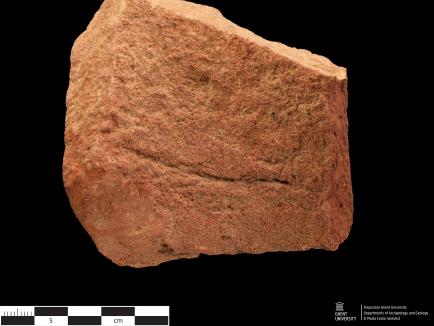Roman - Ceramic building material (5.CBM.BE.0002)
Hand specimen pictures (macro & binocular)
Thin section pictures
Find location
- Category
- Ceramic building material (Roman)
- Fabric name
- Chronology
- Roman > Middle Roman / Late Roman > 2nd-3rd century CE ?
- Dating method(-s)
- /
- Potters' mark
- No
- Additional information
- tile fragment
Find location
- Site type
- Pottery production
- Location
- Belgium; Oost-Vlaanderen; Temse
- Site name
- Temse, Markt/Oeverstraat
- Excavation or Survey Team
- Archeologische Dienst Waasland (ADW)
- Additional contextual information
- site code: Te.M.96; TEM 96/OII/4 BK53, kiln 2
- Surface color
- orange
- Surface texture
- Rough
- Fracture color
- orange red
- Inclusions (non-plastics/tempering)
- quartz; black porous inclusions
- Matrix and voids
- vesicles and vughs (up to 3-4 mm)
- Diagnostic features
- Additional information
- sample TE_M_ST2
- Flepostore inventory nr.
- ARCH1.L1.B3
- Original inventory nr.
- A0019
- Collection
- Archaeological Department, Ghent University
- Type
- Covered thin section
- Comparable thin section(s)
- Matrix
-
Oxidized red fabric; redbrown (PPL), dark brown to dark grey (XP).
Semi-heterogeneous matrix, non-calcareous with no optical activity.
- ca. 35-50% - Inclusions
-
Quartz (++; cf: -; mono, sr-sa, fine to medium sand; ff: +; mono, poly, sr-sa, (very) fine sand to silt; bimodal), sedimentary rock detritus (+-; possible quartz arenite, ff), chert/flint (+-; ff, weathering, alteration), muscovite mica (+; ff, el), feldspars (-; plagioclase, microcline), O/Fe (+), clay pellets (+-, iron-rich).
The coarse fraction varies from medium to fine sand, the fine fraction from (very) fine sand to silt. Grains are generally subrounded to subangular. Bimodal, most likely natural. Overall the fabric is moderately to poorly sorted, moderately orientated and close spaced.
- ca. 40-50% - Voids
-
Small planar voids and larger vughs, well aligned parallel to the edge, some infill (resin/epoxy?). Drying cracks associated with iron oxides and clay pellets.
- ca. 10-15% - Diagnostic features
- The fabric is characterized by a semi-heterogeneous oxidized matrix with no optical activity and moderate porosity. Dominant quartz inclusions with frequent muscovite mica and opaques/iron oxides, common sedimentary rock detritus, chert/flint, iron-rich clay pellets, and few feldspars. Bimodal (natural). Overall (moderately) poorly sorted fabric consisting of mainly fine inclusions with little matrix.
- Additional information
- Same fabric as A0018.
- Sample type
- Building material (decorative, construction)
- Inventory number
- 5.CBM.BE.0002
- Collection
- Archaeological Department, Ghent University
- Donating institute/person
- Onroerenderfgoeddepot Waasland, Erfpunt
- Host collection
- Onroerenderfgoeddepot Waasland, Erfpunt
- Other samples available
- No
- Sample collection method
- Archaeological Excavation
Van Roeyen 1996
- Full reference
-
Van Roeyen J.-P. 1996. Gallo-Romeinse pannenbakkers op de markt te Temse. Gemeentemuseum van Temse, Jaarboek 1996: 62-75.
Van Roeyen 1997
- Full reference
-
Van Roeyen J.-P. 1997. Gallo-Romeins productiecentrum voor bouwceramiek te Temse (0.-Vl.). Romeinendag 1997: 14-19.
Cite this page as: Flepostore - https://flepostore.ugent.be/ceramics/5-cbm-be-0002
Last modified: 2024-04-23.






